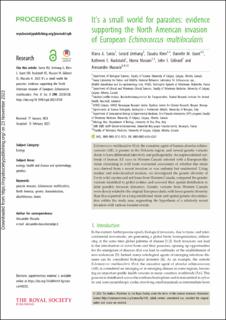| dc.contributor.author | Santa, Maria A. | |
| dc.contributor.author | Umhang, Gerald | |
| dc.contributor.author | Klein, Claudia | |
| dc.contributor.author | Grant, Danielle | |
| dc.contributor.author | Ruckstuhl, Kathreen E. | |
| dc.contributor.author | Musiani, Marco | |
| dc.contributor.author | Gilleard, John S. | |
| dc.contributor.author | Massolo, Alessandro | |
| dc.date.accessioned | 2023-11-24T11:59:26Z | |
| dc.date.available | 2023-11-24T11:59:26Z | |
| dc.date.created | 2023-06-19T10:41:47Z | |
| dc.date.issued | 2023 | |
| dc.identifier.citation | Proceedings of the Royal Society of London. Biological Sciences. 2023, 290 (1994), . | en_US |
| dc.identifier.issn | 0962-8452 | |
| dc.identifier.uri | https://hdl.handle.net/11250/3104539 | |
| dc.description.abstract | Echinococcus multilocularis (Em), the causative agent of human alveolar echinococcosis (AE), is present in the Holarctic region, and several genetic variants deem to have differential infectivity and pathogenicity. An unprecedented outbreak of human AE cases in Western Canada infected with a European-like strain circulating in wild hosts warranted assessment of whether this strain was derived from a recent invasion or was endemic but undetected. Using nuclear and mitochondrial markers, we investigated the genetic diversity of Em in wild coyotes and red foxes from Western Canada, compared the genetic variants identified to global isolates and assessed their spatial distribution to infer possible invasion dynamics. Genetic variants from Western Canada were closely related to the original European clade, with lesser genetic diversity than that expected for a long-established strain and spatial genetic discontinuities within the study area, supporting the hypothesis of a relatively recent invasion with various founder events. | en_US |
| dc.language.iso | eng | en_US |
| dc.rights | Navngivelse 4.0 Internasjonal | * |
| dc.rights.uri | http://creativecommons.org/licenses/by/4.0/deed.no | * |
| dc.title | It's a small world for parasites: evidence supporting the North American invasion of European Echinococcus multilocularis | en_US |
| dc.title.alternative | It's a small world for parasites: evidence supporting the North American invasion of European Echinococcus multilocularis | en_US |
| dc.type | Peer reviewed | en_US |
| dc.type | Journal article | en_US |
| dc.rights.holder | © 2023 The Authors | en_US |
| dc.description.version | publishedVersion | en_US |
| cristin.ispublished | true | |
| cristin.fulltext | original | |
| cristin.qualitycode | 2 | |
| dc.identifier.doi | 10.1098/rspb.2023.0128 | |
| dc.identifier.cristin | 2155704 | |
| dc.source.journal | Proceedings of the Royal Society of London. Biological Sciences | en_US |
| dc.source.volume | 290 | en_US |
| dc.source.issue | 1994 | en_US |
| dc.source.pagenumber | 11 | en_US |

